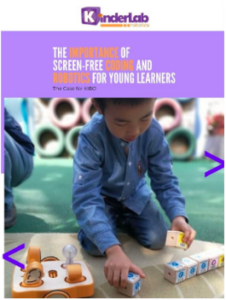eSchoolNews: How We Use Robots and Art to Make Meeting Computer Science Standards Fun
In this article, Erin Wicklund, library media specialist for Meadowbrook Elementary School, Hillsdale Public Schools, in Hillsdale, New Jersey, describes how she meets her STEAM goals and Computer Science standards with the screen-free KIBO robot.
Erin also shares lesson plans for creating exciting, multidisciplinary STEM learning for 1st- and 2nd-grade students. “We’ve been able to teach coding as an integral part of our larger curriculum. This approach has allowed us to create interdisciplinary lessons that spark curiosity, imagination, and engagement.”
The article reads in part:
“With KIBO, a hands-on coding robot designed specifically for young learners, we have a screen-free way to introduce robotics and coding to elementary school students. We’re able to combine coding with art and show students the parallel between programming and storytelling. A prime example of this interdisciplinary approach was the lesson plan I wrote for our 2nd-grade students.
The synergy of science and storytelling
The book Balloons Over Broadway tells the true story of the master puppeteer who invented the first balloons for the Macy’s Thanksgiving Day Parade. Using the book as inspiration, I created a prompt guiding students to transform their KIBO robots into floats and recreate the parade by coding them to navigate the route down “Broadway.” During library media classes, students coded the parade performance using the wooden programming building blocks, and the computer science assisted with green screen filming and editing to recreate the New York City backdrop depicted in the book. Our art teacher introduced the students to Jeff Koons, instructing them to take artistic inspiration from the artist’s iconic balloon dog.
For the final product, we produced a video that showcased the students’ programmed KIBO robots navigating a parade route through a virtual New York City. The lesson merged creative storytelling and art with technology, robotics, and engineering. Watching my students’ faces light up as they saw their creations come to life was a powerful reminder of the impact of hands-on, integrated STEAM projects like this one.
Nursery rhymes with a technology twist
The success of my Balloons over Broadway lesson inspired me to take a similar approach for our 1st-graders, using nursery rhymes as the jumping-off point. This particular lesson plan was mapped to a story-retelling literacy standard that uses the “first, next, then, last” structure, which is similar to patterns that students use in programming. By integrating this retelling format into the lesson, I was able to create a natural connection to the coding component. The students were able to collaboratively construct coding sequences that mirrored the familiar story structure, creating a better understanding of the technology, while also problem-solving by exploring which KIBO programming blocks they felt were necessary to tell the story of the nursery rhyme to the audience.
I presented the class with several classic nursery rhymes to retell, including Itsy Bitsy Spider, Humpty Dumpty, Little Bo Peep, and Hey Diddle Diddle. After creating their coding sequences, students used KIBO’s wooden programming blocks to guide their robots in retelling the stories. They brainstormed and collaborated on what sounds and actions best matched the action in the nursery rhymes, then programmed their robots accordingly. The project ended with groups presenting four different characters they designed on a tissue box and placed on KIBO’s art platform, so that each of the students in each group could have their own character.
It was remarkable to witness their creative problem-solving, and I had never seen them so calm and supportive of each other. Everybody applauded!
To prepare for the new school year, I have received a few extensions for KIBO, including the Marker Extension Set and the Free Throw Extension Set. My plan for the upcoming fall class is to ask the students to devise their own lesson plans using these new tools. I can’t wait to see what the students come up with–the way our first graders were troubleshooting their projects during the nursery rhyme retelling lesson makes me confident that the students are ready to build upon their previous work and take it to the next level.
These lessons give my students learning scenarios that prepare them for the interconnected challenges of the real world, especially when it comes to technology and creative problem-solving. By creating lesson plans that not only meet current computer science standards but also anticipate future challenges, I’m equipping my young students with the diverse skillset they need to thrive in our ever-evolving world.”



















